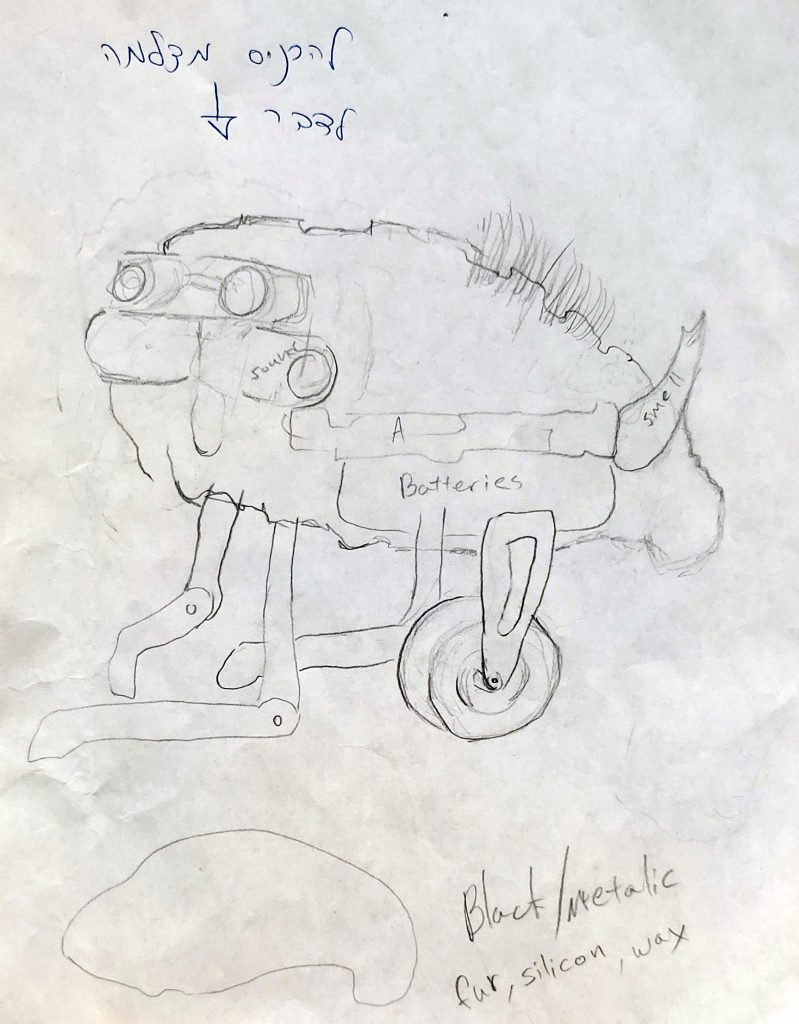Creative Requirements
Essential movements: The minimum requirement is the ability to move forward in one direction. The ideal requirement is the ability to move forward and change the direction of movement while moving.
Tempo, pace, or speed for each movement: Spees of movement should be relatively slow (although, the speed of movement is less essential, as long as it’s not extremely fast).
Overall size: Ideally, about 50cm x 30cm x 30 cm (LXWXH – in inch: 20x12x12). However, I do understand that as part of the class I can only produce a much smaller model.
Visual design language: Something between a machine and a small animal, skin-like, with the color range of my pet rabbit (white-brown)
Materials, colors, and textures: The robot needs to have the conventional opaque milky white color of silicone rubber, with fur punched into its top surface (the fur color range is white-brown).
Technical Critical Path
The simplest version of the system which can address the creative goals: creating a similar, yet bigger in scale, model of the Whitesides’ soft robot – https://www.youtube.com/watch?v=ZrrM-QZ-xDI&t=4s. https://www.semanticscholar.org/paper/Multigait-soft-robot-Shepherd-Ilievski/b217c8d7e5a22dadd14f42b80b86224596882046
An ideal version will include a more controlled motion method, although perhaps the Whitesides’ soft robot can be sufficient as a base model, and once/if I’m successful in recreating it, I can then focus on applying specific aesthetic changes to adjust it to my project.
Proof-of-concept
Productive first step / first experiment:
For the simplest version: Creating a similar model of the Whitesides’ soft robot – in order to establish I can create the simplest version of my idea and observe how the fur punching integrates with the original design.
For the ideal version: Creating a soft robot that is partly based on M. T. Tolley’s soft robot from 2014, or on Dylan Drotman’s soft robot from 2021 (see references). Tolley’s soft robot is ideal because it’s still made out of silicone rubber (unlike Dylan Drotman’s soft robot) but is capable of the controlled direction of movement (Can be seen at Drotman’s documentation video between 00:10-00:19 https://youtu.be/bnT6BBkDYlc). An important feature of both Tolley’s and Drotman’s soft robots: they are untethered, which is not necessary for my idea.
In conclusion, I’m hoping to incorporate a controlled locomotion method into Whitesides’ soft robot.
Original sketch:

References:
M. T. Tolley, R. F. Shepherd, B. Mosadegh, K. C. Galloway, M. Wehner, M. Karpelson, R. J. Wood, G. M. Whitesides, A resilient, untethered soft robot. Soft Robot. 1, 213–223 (2014). https://www.liebertpub.com/doi/10.1089/soro.2014.0008
Dylan Drotman, Saurabh Jadhav, David Sharp, Christian Chan, and Michael
T. Tolley. Electronics-free pneumatic circuits for controlling
soft-legged robots. Science Robotics, February 2021.
doi:10.1126/scirobotics.aay2627.